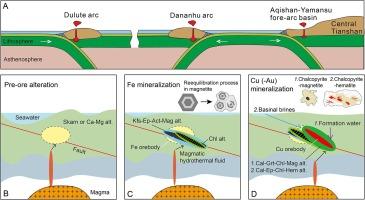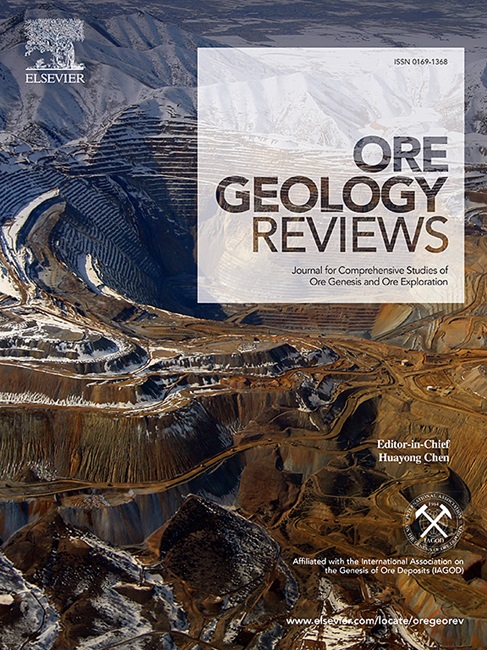Tectonic setting, mineralization, and ore geochemistry of the Paleozoic IOCG deposits in Xinjiang, NW China
IF 3.2
2区 地球科学
Q1 GEOLOGY
引用次数: 0
Abstract
The Paleozoic iron oxide copper–gold (IOCG) deposits in Xinjiang correspond to magmatic arc formations (Andean type) within the Central Asian Orogenic Belt (CAOB). These deposits include the Heijianshan, Duotoushan, Shuanglong, and Shaquanzi deposits in the Aqishan-Yamansu belt of Eastern Tianshan, which formed during the inversion of a continental arc-related basin (ca. 310–300 Ma). In contrast, the Laoshankou and Qiaoxiahala deposits along the northern margin of Eastern Junggar formed in an island arc setting (380–370 Ma). Detailed paragenetic studies of these deposits reveal a wide variety of alteration and mineralization patterns, including distinct but typical styles of magnetite and copper–gold mineralization. Fluid inclusion data and isotope tracing of ore-forming fluids indicate the involvement of magmatic-hydrothermal fluids is responsible for the early magnetite mineralization. However, for the late copper–gold mineralization, the deposits formed during the basin inversion have a significant involvement of non-magmatic fluids compared to those of island arc-related deposits. These non-magmatic fluids include basinal brines or residual seawater that reacted with andesitic host rocks. Comparing the IOCG-related magmatic rocks, the regional Bailingshan intrusive complex in the Eastern Tianshan formed during the basin inversion is from more reduced and water-poor parental magma compared to arc magma in the Eastern Junggar. However, the tectonic setting (basin inversion) facilitated the migration and involvement of external fluids, including sulfur, in the mineralization process, potentially compensating for the deficiencies of the magma to generate late economic copper–gold mineralization.

中国西北部新疆古生代 IOCG 矿床的构造背景、成矿作用和矿石地球化学特征
新疆的古生代氧化铁铜金(IOCG)矿床与中亚造山带(CAOB)内的岩浆弧构造(安第斯型)相对应。这些矿床包括东天山阿克苏-雅满苏带的黑尖山、多头山、双龙和沙泉子矿床,它们形成于大陆弧相关盆地的反转过程中(约 310-300 Ma)。相比之下,东准噶尔北缘的老山口和桥下哈拉沉积则形成于岛弧环境(380-370Ma)。对这些矿床进行的详细成因研究揭示了多种多样的蚀变和矿化模式,包括风格独特但典型的磁铁矿和铜金矿化。流体包裹体数据和矿石形成流体的同位素追踪表明,岩浆-热液的参与是早期磁铁矿化的原因。然而,就晚期铜金矿化而言,与岛弧相关矿床相比,盆地反转过程中形成的矿床有大量非岩浆流体参与。这些非岩浆流体包括与安山岩主岩发生反应的基底盐水或残余海水。对比与IOCG相关的岩浆岩,与东准噶尔地区的弧形岩浆相比,在盆地反转过程中形成的东天山地区白灵山侵入复合岩浆来自于更加还原和贫水的母岩。然而,构造环境(盆地反转)促进了外部流体(包括硫)的迁移和参与成矿过程,有可能弥补岩浆的不足,从而产生后期经济的铜金矿化。
本文章由计算机程序翻译,如有差异,请以英文原文为准。
求助全文
约1分钟内获得全文
求助全文
来源期刊

Ore Geology Reviews
地学-地质学
CiteScore
6.50
自引率
27.30%
发文量
546
审稿时长
22.9 weeks
期刊介绍:
Ore Geology Reviews aims to familiarize all earth scientists with recent advances in a number of interconnected disciplines related to the study of, and search for, ore deposits. The reviews range from brief to longer contributions, but the journal preferentially publishes manuscripts that fill the niche between the commonly shorter journal articles and the comprehensive book coverages, and thus has a special appeal to many authors and readers.
 求助内容:
求助内容: 应助结果提醒方式:
应助结果提醒方式:


